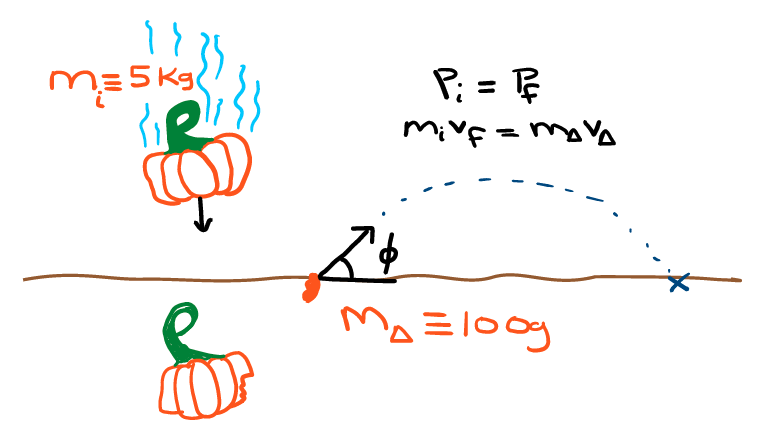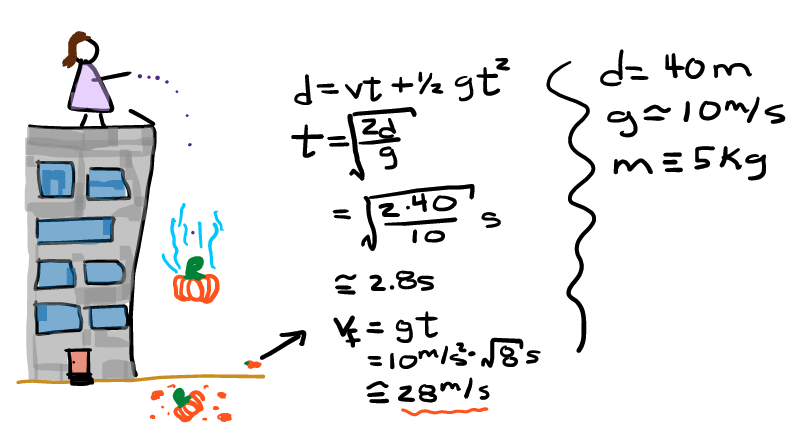That’s Some Gourd Acceleration!
Fall
2024
Physics Puzzler
That’s Some Gourd Acceleration!
Brad R. Conrad, Education and Workforce Development Manager, Office of Advanced Manufacturing at NIST
For many of us in the Northern Hemisphere, September through December is a season of dipping temperatures, falling leaves, dwindling pumpkin spice latte supplies, and annual pumpkin drops! It may sound a little out there, but many SPS clubs have a long history of splattering pumpkins around Halloween to raise money, build awareness of their SPS and Sigma Pi Sigma chapters and department, or even—as former members of SPS have put it—to demonstrate a love of physics.
The SPS chapter at California State University (CSU), Chico, has a long history of such events, as is evident in their project proposal for a 2016 Marsh White Outreach Award:
The Pumpkin Drop reenacts Galileo Galilee's Tower of Pisa experiment. On Halloween, SPS members dress as Einstein, Aristotle, Newton, and Galileo to explain the evolution of the rule of falling bodies as other SPS members demonstrate the rule by dropping pumpkins from the fifth floor of CSU Chico’s Butte Hall… At the top are two dozen hollowed-out pumpkins, either empty, filled with water, feathers, or fire, ready to be dropped by SPS members….
The Pumpkin Drop was originally thought of by physics students, based off the dropping of fruit from a five-story tower as featured in the Late Night with David Letterman show [a late-night talk show]. In 1988, SPS members Ben Catching and David Snyder wanted to demonstrate a love for physics for the entire campus and community….
In the early 1990s, Scot Carter added the finale of coordinating smashing pumpkins with the cannon blasts of the “1812 Overture.”
When I explain that it is very common for physics and astronomy departments to drop pumpkins off a building to nonscience types, I get a lot of worried looks. And. It. Is. Amazing! I think pumpkin drops get to the heart (or in this case, the pulp) of why we study the world around us: a love of physics and astronomy.
If I wanted to host a pumpkin drop at my workplace, let’s say off the tallest building at the National Institute of Standards and Technology (NIST) Gaithersburg Campus, which is about 12 stories, how big of a plastic sheet would I need to place on the ground to catch all of the splatter? (And if I did a pumpkin drop at NIST, would it be the “standard” pumpkin drop? NIST keeps the SI standards for the country, so why not pumpkin drops?)
For experimental insight, we can look at some amazing examples from physics, astronomy, and engineering clubs across the country:
In 2022, CSU Chico’s chapter held its 33rd Annual Pumpkin Drop. To see a video, visit bit.ly/46zczsY.
In 2023, the physics department at Florida Atlantic University (FAU) held its Annual Pumpkin Drop. To see a video, visit bit.ly/4ce4xqD.
Kourtney Adkisson Libenow, who helped with pumpkin drops at Central Washington University when she was an undergraduate, says that pieces regularly spread within a 20-ft diameter around the point of impact after a six-story drop.
There are several ways to approach this question using the first-semester physics tools of kinematics and conservation of energy. However, first we need to think through the problem and some assumptions.
We know that when things fly through the air, there is definitely air resistance. The force of air resistance goes as velocity squared and will eventually cause a falling object to reach a terminal velocity. It does take time to reach a terminal velocity, though. For example, it takes skydivers over 10 seconds to reach their terminal velocity.
We can see from the video evidence that in a typical pumpkin drop, the pumpkins don’t fall for anything close to 10 seconds. It’s about 3 seconds. Thus, let us assume we can use conservation of energy to calculate how fast a standard 10-lb pumpkin is falling right before it hits the ground.
HERE‘S THIS ISSUE’S PUZZLER: If we drop a standard pumpkin off a 12-story building, how far could the splatter travel?
Part 1: Using information in Fig. 1, how fast is the pumpkin traveling just before it hits the ground?
Now, when the pumpkin hits the ground—no matter if it’s filled with feathers, fire, or liquid nitrogen—it will not remain intact. The pumpkin will break apart and many pieces will fly up, as we can see in the FAU and CSU Chico videos.
This collision is inelastic—we lose energy EVERYWHERE! The landing makes a sound. It takes energy to break the pumpkin into pieces. Some molecular bonds break. The pumpkin warms up. There’s lots of friction with pieces moving around. But, for the sake of science, let’s assume that all the momentum of the pumpkin goes into a single piece of pumpkin. Let’s also assume that the piece is a small hunk only 100 g in mass (some seeds and a bit of the pumpkin flesh). How far could that single piece of pumpkin fly?
Part 2: Using what you've found so far and Fig. 2, what would the chunk's initial velocity be when it leaves the pumpkin? How far could that piece of pumpkin go?
If you remember the angle that results in the farthest trajectory for a launch, you should get something significantly larger than 20 feet. To make sure that everyone in a crowd stays pumpkin-free during my drop, how large of a blocked-off area would we need if there was NO air resistance?
Does your answer make sense?
Hypothetically, if a typical piece flies a maximum of 50 feet for a drop of 12 stories, how much energy is lost to air resistance as compared to your air-resistance-free situation? Is air resistance going to be significant at the initial velocity you calculated in part 1?
Read More
Check out the Winter 2020 SPS Observer article, “Why You Should Host a Pumpkin Drop—And How to Make It Happen #SPSplat,” by Deanna Marshall at spsnational.org/the-sps-observer/issues/winter-2020.


